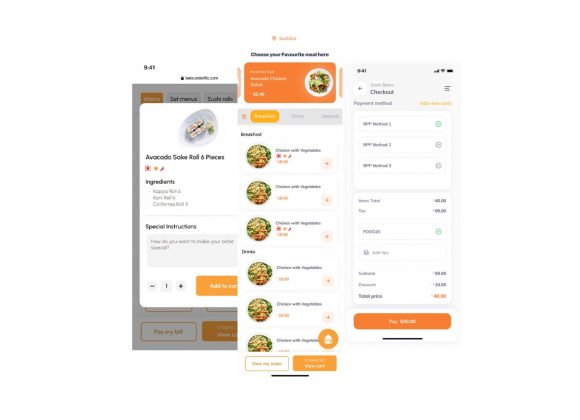From its humble beginnings in Southern China, Cheung fun has since become a crowd favorite globally. This delicious and versatile snack is celebrated for its simplicity; the combination of steamed rice noodles and numerous fillings is easy to customize while remaining flavorful at every turn. With endless combinations of ingredients that all result in something tasty, Cheung fun provides an enjoyable experience no matter how you prepare it.
In this blog post, we will explore just what makes this iconic street food dish so delicious – from classic recipes to modern variations – and provide detailed instructions on making your own Cheung fun rolls right at home!
Overview of Cheung Fun and Its Origins
Cheung Fun, also known as rice noodle rolls, is a popular Cantonese dish that originated in southern China. It is a type of dim sum typically enjoyed during breakfast or as a light snack. The dish consists of delicate and smooth rice noodle sheets made from a batter of rice flour, water, and sometimes other starches.
These delicate sheets are expertly steamed and generously filled with a delectable assortment of savory ingredients, including succulent shrimp, flavorful char siu (barbecued pork), tender beef, or an array of fresh vegetables.
Cheung Fun delights the palate with its delicate noodle rolls, ideally accompanied by a medley of flavorful sauces. The harmonious combination of soy sauce, hoisin sauce, oyster sauce, and sesame oil enhances the subtle essence of this exquisite dish, creating a genuinely delectable culinary experience.
What Does Cheung Fun Taste Like?
Cheung Fun, or rice noodle rolls, have a unique and delightful, delicate, and comforting taste. The main flavor comes from the rice noodle sheets themselves, which are mild and slightly sweet with a subtle rice essence.
The texture is soft, smooth, and almost translucent, giving them a light and pleasant mouthfeel. The filling adds additional layers of taste; for instance, shrimp contributes a natural sweetness, char siu adds savory richness, and vegetables offer freshness.
The rolls themselves are relatively plain, allowing the filling to take center stage. The taste is a combination of savory and slightly sweet flavors, with hints of soy sauce and spices. Overall, Cheung fun is a unique and delicious dish that is sure to impress.
The Best Flour for Rice Noodle Rolls
The best flour for making rice noodle rolls (cheung fun) is rice flour. Rice flour is made from finely ground rice and is the primary ingredient in traditional rice noodle roll recipes. It gives the noodle rolls their characteristic delicate and smooth texture.
For the best results, look for rice flour specifically labeled for making rice noodle rolls or steamed rice cakes. Some recipes may also use a small amount of cornstarch or tapioca flour to enhance the chewiness and elasticity of the noodle sheets, but rice flour remains the critical ingredient for achieving authentic and delicious rice noodle rolls.
How To Make Rice Noodle Rolls (or Rice Noodles!)
Batter for Rice Noodle Rolls
Preparing the batter for rice noodle rolls is a straightforward process that calls for a handful of essential ingredients. Below is a recipe to guide you in creating the perfect batter:
Ingredients:
– 1 cup rice flour
– 2 tablespoons cornstarch
– 1 tablespoon tapioca flour or tapioca starch (optional for added chewiness)
– 1 1/2 cups water
– 1/2 teaspoon salt
– 1 tablespoon vegetable oil
Instructions:
- In a mixing bowl, combine the rice flour, cornstarch, tapioca flour (if using), and salt. Mix the dry ingredients together thoroughly.
- While stirring continuously, gradually incorporate the water into the dry mixture, ensuring a smooth batter without any lumps.
- Incorporate the vegetable oil into the batter and thoroughly combine. Adding oil will prevent the rice noodle rolls from adhering to the steamer, ensuring a smooth and seamless cooking process.
- Recommended: Allow batter to rest for approximately 20-30 minutes. During this period of rest, the flour fully absorbs moisture, creating rice noodle rolls that are not only smoother but also more elastic in texture.
- After allowing the batter to rest, please thoroughly stir before using it. The ideal consistency should be thin and smooth, akin to that of heavy cream. If the batter appears too thick, incorporate a small amount of water to attain the desired consistency.
Now, you are prepared to create your delicious rice noodle rolls.Start by pouring a thin layer of the batter onto a greased and heated steamer tray. Steam until it sets, typically around 2-3 minutes, and your steamed rice rolls or noodle rolls are ready.
Sauce for Rice Noodle Rolls
The preparation of the sauce for rice noodle rolls is equally vital to the process of making the rolls themselves. It is imperative to prioritize and pay attention to both aspects to ensure a delightful culinary experience. There are various versions of the sauce, but here is a straightforward recipe for a timeless savory sauce that beautifully complements the delicate flavors of rice noodle rolls –
Ingredients:
– 3 tablespoons soy sauce (light or dark soy sauce)
– 2 tablespoons hoisin sauce
– 1 tablespoon oyster sauce
– 1 tablespoon sesame oil
– Sugar (adjust to taste)
– 1/2 cup water
– 1 clove garlic, minced (optional)
– 1/2 teaspoon white sesame seed (optional)
Instructions:
- Let’s bring together a tantalizing medley of flavors in a small saucepan! Combine the soy sauce, hoisin sauce, oyster sauce, sesame oil, sugar, water, and minced garlic (if using). Please give it a good mix, ensuring all the ingredients dance together harmoniously.
- Gradually heat the saucepan over low to medium heat, allowing the mixture to gently simmer. Stir occasionally to ensure the flavors meld harmoniously.
- You have the perfect opportunity to introduce some fiery elements to give the sauce an extra kick of spiciness. Consider adding a tantalizing dose of chili oil or zesty chili sauce at this very moment. Get ready to ignite your taste buds!
- Allow the sauce to simmer for approximately 2-3 minutes, enticing it to thicken ever so slightly. Should the sauce dare to become overly thick, fear not! Introduce a touch of water to achieve the desired consistency.
- Indulge in a tantalizing taste of the sauce and perfect its sweetness or saltiness by adding a touch of extra sugar or soy sauce, as needed.
- Once the sauce is prepared, give it a moment to cool off the heat before serving. This simple step will elevate the dish, preserving its true essence while enhancing its overall quality.
Consider delicately sprinkling a handful of white sesame seeds on top for an enhanced texture and presentation. The sauce for your rice noodle rolls is now prepared and ready to be served alongside the freshly made rolls. Enjoy the perfect pairing of flavors!
Do I Need a Special Rice Roll Maker?
No, you do not need a special rice roll maker to make rice noodle rolls (cheung fun) at home. While some specialty dim sum restaurants may use specialized equipment to mass-produce steamed rice noodle rolls, you can easily make them using common kitchen tools.
To make steamed rice noodle rolls at home, you will need a steamer, a steamer tray or a flat heatproof dish, and a clean cloth or a sushi rolling mat to help with rolling.
With these basic kitchen tools, you can make delicious and authentic rice noodle rolls from scratch. Remember to follow the steps in the recipe and the best practices for rolling and cutting the rice noodles to achieve the best results.
How to Store Cheung Fun
Storing Cheung fun (rice noodle rolls) properly will help maintain their freshness and prevent them from drying out. Here are the steps to store cheung fun:
- Cooling and Drying: After making the rice noodle rolls, let them cool to room temperature on a plate or a clean surface. Avoid stacking or overcrowding the rolls during this process to prevent sticking.
- Individual Wrapping: Once cooled, you can individually wrap each rice noodle roll in plastic wrap or parchment paper. This step is crucial to prevent them from sticking together.
- Refrigeration: Place the wrapped rice noodle rolls in an airtight container or a sealable plastic bag. Make sure to remove any excess air from the container to keep the rolls fresh. Store the container of wrapped rice noodle rolls in the refrigerator. Typically, they can maintain their quality for approximately 2-3 days without any noticeable decline.
- Reheating: To savor the rice noodle rolls, delicately steam them once more until they are warmed through. This process will restore their tender and exquisite texture, ensuring an enjoyable dining experience.
- Serving: Enhance your dining experience by pairing the reheated rice noodle rolls with your favorite sauce or dipping sauce. Indulge in a delectable and gratifying meal or snack.
Keep in mind that rice noodle rolls are most enjoyable when consumed fresh. It is recommended to savor them within one to two days after preparation. However, if stored properly and reheated with care, they can still maintain their delightful flavor and texture.
How to Eat Cheung Fun
Cheung fun, a staple dish in Cantonese cuisine, is a delightful snack perfect for satisfying your hunger pangs. This dish is essentially rice noodle rolls stuffed with various ingredients like shrimp, pork or vegetables. To savor the delicious flavors of Cheung fun, there are a few things you should keep in mind.
- Firstly, use chopsticks to pick them up to avoid ruining their delicate texture.
- Secondly, dip them in soy sauce to add a salty tang or plate them with some green onions or sesame sauce to enhance their flavor.
- Remember to take small bites instead of stuffing the entire roll into your mouth.
Following these tips will surely enhance your experience while enjoying this delectable and satisfying dish.
Conclusion
Cheung fun is a beloved dish with delicious flavors that delight diners of all ages. Cheung fun remains a staple food for many cultures, from its origins in Cantonese dim sum to the tasty varieties enjoyed today.
We have discussed the nature of Cheung fun and the best ingredients that make rice noodles as tasty and delightful as possible. Additionally, we have discussed if you need any special tools such as a rice roll maker, how to store them, and most importantly how to enjoy this wonderful dish.
Rice noodle rolls will surely be a hit among your guests no matter what event or occasion. So why not try Cheung fun and delve into the world of deliciousness? Your taste buds won’t regret it! If you’re looking for more interesting recipes and food-related information, make sure you check out Orderific’s blogs for lots of great ideas.
FAQs
Q. What is Cheung Fun, and what are the main ingredients used in its preparation?
Ans. Cheung Fun is a Cantonese dish made from rice noodle rolls, typically filled or served with ingredients like shrimp, beef, or vegetables.
Q. Can you provide insights into the traditional methods and techniques involved in making Cheung Fun?
Ans. Traditional Cheung Fun is made by steaming rice batter on cloth-lined trays and rolling the cooked sheets with fillings using bamboo sticks.
Q. Are there variations of Cheung Fun available with different fillings or toppings, and what are some popular options?
Ans. There are various Cheung Fun variations with fillings like char siu (barbecued pork), dried shrimp, mushrooms, or sweet versions with red bean paste.
Q. Can you recommend some accompanying sauces or condiments that complement the flavors of Cheung Fun?
Ans. Common sauces paired with Cheung Fun are sweet soy sauce, hoisin sauce, and sesame sauce to enhance its taste.













